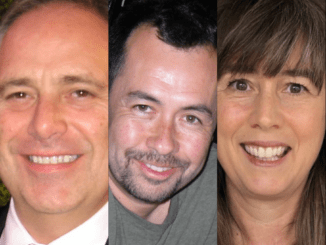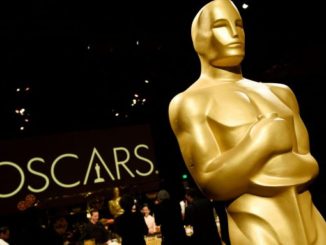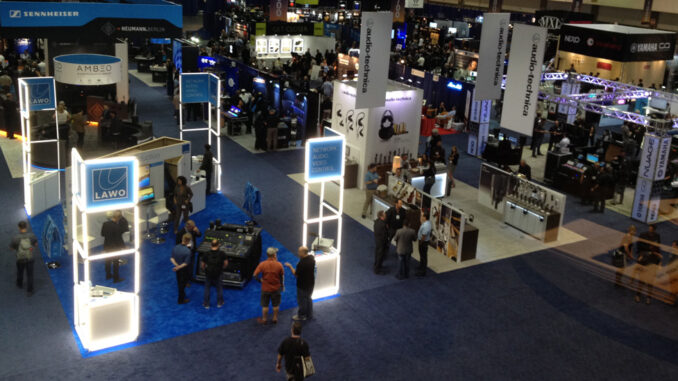
story and photos by Mel Lambert
The 141st Audio Engineering Society Convention, held recently in the Los Angeles Convention Center’s West Hall, attracted a record West Coast attendance, with a wide cross-section of brands showing their wares on the exhibition floor and companion demo rooms. Aimed squarely at evolving technologies via a special focus on new markets and trends, the four-day convention took the highly appropriate theme of Immersed in Audio. “That pretty well sums up where [our industry] needs to move forward in the world of new audio technologies,” noted AES president John Krivit. “Sound for picture, networked audio and game audio were all covered here with a full technical program of workshops, tutorials and exhibits.”
The co-located Audio for Virtual and Augmented Reality Conference drew standing-room-only attendance in a lecture theatre and companion papers room. Originally expected to attract some 290 attendees, aggressive outreach to the VR and AR communities proved so successful that pre-registration for the inaugural two-day event had to be closed at just over 400, with sponsorship from Audiokinetic Dolby, DTS, Dysonics, Gaudio, Nokia, Occulus, Sennheiser, Source Sound and VisiSonics.
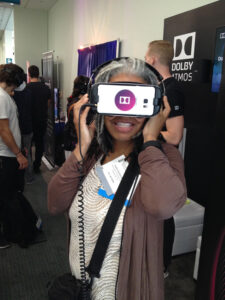
“Just as TV programming progressed from live broadcasts of staged performances to today’s complex language of multi-thread, long-form content, so such media will progress from projecting existing media language into a headset experience to a new VR/AR/MR-specific language that both creatives and audiences understand,” keynote speaker Philip Lelyveld stressed.
Targeted squarely at the rapidly growing field of virtual and augmented reality audio, the program focused on the AR/VR creative process, applications workflow and product development. “Film director George Lucas once stated that sound represents 50 percent of the motion picture experience,” offered conference co-chair and AES past president Andres Mayo. “Our conference demonstrated that VR and AR productions require audio that follows the motions of the subject, and produces a realistic immersive experience.”
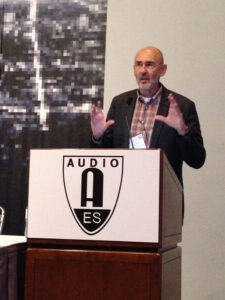
The event was bookended by two keynotes from leading VR/AR proponents. The first, presented by Philip Lelyveld from the USC Entertainment Technology Center and entitled The Journey into Virtual and Augmented Reality, defined how virtual, augmented and mixed reality will impact entertainment, learning and social interaction. “Just as TV programming progressed from live broadcasts of staged performances to today’s complex language of multi-thread, long-form content, so such media will progress from projecting existing media language into a headset experience to a new VR/AR/MR-specific language that both creatives and audiences understand,” Lelyveld stressed.
The closing keynote from George Sanger, director of sonic arts at Magic Leap, and entitled Future Nostalgia, Here and Now: Let’s Look Back on Today from 20 Years Hence, tried to predict where VR/AR/MR will be in two decades. “Two decades of progress can change how we live and think in ways that boggle the mind,” he acknowledged. “Twenty years ago, PCs had rudimentary sound cards; now an entire multi-track recording studio lives on our computers. By 2036, [consumers] will be wearing lightweight portable devices all day. Our media experience will seamlessly merge the digital and physical worlds; how we listen to music will change dramatically. We live in the revolution of possibilities,” he concluded.
Several sessions from the convention’s Sound for Picture Track offered valuable insights for the film and TV post community. As session chair Brian McCarty from Coral Sea Studios, Australia, stated, “The world’s largest group of working sound engineers are those handling sound for picture, a community that is dramatically expanding.”
During the World-Class Film and TV Sound Design panel, Lon Bender, MPSE, from Formosa Group and Brett Hinton from Atomic Sound discussed how sound designers work with film directors and TV producers to develop fully detailed soundtracks. Bender, whose extensive credits as supervising sound editor include The Revenant and Hunger Games, offered, “Sound is a subjective element; we try to understand the director’s and the film editor’s ideas and develop a common language. We need to concentrate on subtexts and the overall feeling of a scene. I like to use organic sounds to design the soundtrack.”
From comments secured during the spotting session, Bender said he begins to “fully understand the director’s requirements. Although I will develop audio sketches from an early picture cut, [directors] need to understand that it’s just a sketch and not the final product. We cannot rush the process; it takes time to develop a soundtrack, all the way to the final mix. My sound design can help re-recording mixers understand the sonic balance within a soundtrack. Our team success comes from continuing collaboration.”
“Sound is a subjective element,” said Lon Bender. “We try to understand the director’s and the film editor’s ideas and develop a common language. We need to concentrate on subtexts and the overall feeling of a scene. I like to use organic sounds to design the soundtrack.”
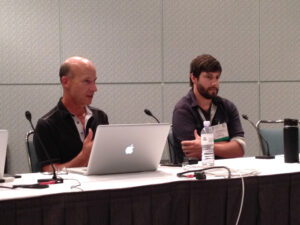
In contrast, Hinton stated that his schedule on TV shows like Falling Water, which premiers on USA Network in mid-October, is more accelerated. “But the process still starts with the script,” he acknowledged. “I look at what is happening story-wise and determine what sounds would support the [narrative]. During the spotting session with the post supervisor — and, hopefully, the show runner — I’ll sketch ideas about the sound design, and how it fits with the dialogue, sound effects and Foley elements. We have seven, maybe 14 days from picture turnover to the final dub, with maybe two re-conforms before the dub — conform software definitely is our friend! — and then maybe two more on the stage, but with not as many edits. We can also retain volume and pan automation.”
During the Immersive Sound Design for Film & TV panel, presented by Nuno Fonseca from ESTG/Polytechnic Institute of Leiria in Portugal, Benjamin Cook (Starz series Black Sails), Jason Jennings (Teenage Mutant Ninja Turtles: Out of the Shadows) and Mark Mangini, MPSE (who secured an Oscar win for director George Miller’s Mad Max: Fury Road), focused on immersive-sound formats used for film and TV shows. “Design of realistic and engaging immersive sound fields is challenging this fast-paced production environment,” Fonseca offered. The Hollywood-based sound designers shared their experiences crafting immersive sound fields and their use of specialty sound design tools.

In terms of innovative product offerings, there was plenty to dazzle the imagination at the Los Angeles confab.
A-Designs Audio introduced the Mix Factory, which accommodates up to 16 audio channels via two D-sub inputs and sums to stereo XLR-format outputs. All 16 channels feature a continuous gain control, pan with center detent and mute switch that also includes a signal-present indicator LED. That same cut button illuminates red when used as a mute, and green when a signal is flowing. A pushbutton option selects either “clean” — a standard setup that bypasses transformers — to “tonal” via the unit’s custom-made output transformers.
Apogee Electronics showed the new Element Series of Thunderbolt audio interfaces for Apple Macintosh AV editing workstations, and which feature different numbers of analog and digital I/Os. Element 24 (a 10-in/12-out configuration), Element 46 (12-in/14-out) and Element 88 (16-in/16-out) feature Apogee’s proprietary Thunderbolt driver that delivers a claimed 1.41 mS round-trip latency with Logic Pro X, whose users can also adjust I/O settings directly from channel strips.
Avid Technology unveiled new features for Pro Tools V12.6 DAW software, with editing/mixing functionality that completes Phase 1 of product development, according to Tony Cariddi, audio segment marketing manager, “giving post professionals even more control over their editing workflow, and enabling faster and more fluid mixing than ever before.” The Clip Effects and layered editing features are said to streamline the edit and mix process, with automatic playlist creation and selection using shortcut keys. Pro Tools V12.6 also offers enhanced in-the-box dubber workflows.
Also to be seen: the new Pro Tools|MTRX audio interface for HDX and HD Native systems, which was developed by Digital Audio Denmark with 64-channel AD and DA converters, configurable monitoring, I/O and routing capabilities. Powered by DAD’s MediaCentral Platform and available Q4 2016, MTRX is said to integrate seamlessly with S6, S3 and other EuCon-capable control surfaces, with extended monitor control and flexible routing. A variety of digital I/O formats are available, including AES3, MADI, Audinate Dante and/or SDI, with optional analog mic pre-amps.
New sales options mean that users can now purchase or subscribe to Pro Tools|HD software as a stand-alone product, independent of hardware bundles. As a result, users can use Avid brand or third-party I/O hardware, or add additional seats for offline editing tasks that may not require high channel counts or DSP acceleration. “With increasingly complex soundtracks, higher client expectations, smaller budgets and shorter turnaround times, today’s audio professionals need to deliver top-quality results quickly and efficiently,” said Tim Carroll, vice president of audio product management.

Staying with Pro Tools connectivity, Focusrite showed a number of I/O options for Pro Tools HD Native on PCIe or Thunderbolt connections, including the Red 4Pre, RedNet AM2 stereo monitoring system and the new Red 8Pre, which offers Red 4Pre features with eight mic pre-amps and a 64-by-64 configuration, including 16 analog inputs and 18 outputs. Red units connect to Pro Tools via mini-DigiLink connectors to Avid interfaces or Sync HD, and also feature Audinate Dante audio-over-IP networking with parallel-path summing.
And Lynx Studio Technology announced new firmware for its Hilo A-to-D Converter that includes a redesigned graphic user interface and menu layout, a full-function Monitor Controller, Master Output Volume to preserve relative levels of each output, and analog VU-style plus horizontal peak-style meter designs. Also to be seen: Audinate Dante network I/O options for Aurora 16 and Aurora 8 24-bit/192 kHz converters that also feature ADAT Lightpipe, MADI and USB ports, and are controllable from ProTools|HD systems.
DPA Microphones showed its range of d:dicate Series of modular microphones, available with both omni-directional and directional capsules, enabling users the ability to mix and match capsules and pre-amplifiers to create the exact microphone needed for any specific voiceover, ADR or Foley assignments.
Eventide demonstrated a new multi-channel/multi-element signal-processing system targeted at the post community, with four simultaneous effects paths. “Plug-ins for Avid Pro Tools and other DAWs are in development,” said Ray Maxwell, vice president of sales and marketing. “The device can also be used with a stand-alone app.” Initially, effects will be draw from existing processors — “with other EQ, dynamics plus reverb effects in development,” Maxwell added — and can be run in parallel or series “to effectively create a fully-programmable, four-element channel strip per processing engine.
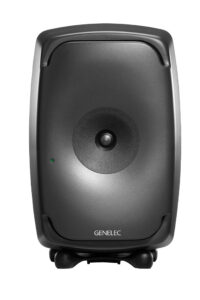
Genelec showcased the Model 8351 Smart Active Monitor for edit suites and small/medium-sized dub stages capable of delivering 110 dB SPL at 1 meter and ±3 dB frequency response of 35 Hz to 40 kHz. With a compact footprint, the three-way monitor’s enclosure features a Minimum Diffraction Coaxial MF/HF driver evolved from the Model 8260 that is said to provide accurate imaging and improved sound accuracy, both on- and off-axis, vertically as well as horizontally. LF woofers are concealed beneath a Directivity Controlled Waveguide, with active powering from Genelec-designed Class D amplifiers.
KRK Systems unveiled the V Series 4 near-field studio monitors for editorial and pre-mix stages, available in four-, six- and eight-inch models. Features include custom-designed Kevlar and woven Kevlar woofer, optimized front-ported bass reflex enclosure design, bi-amped Class-D amplification, and acoustic- and desk-loading condition correction with LF equalization. The monitors include user-selectable equalizer settings to ensure correct setup for room acoustics and placement anomalies as well as individual preference.
Neutrik unveiled new additions to its etherCON Series, including etherCON Cat6A with a cable carrier that features an RJ45 connector for self-termination, feed-through D-size chassis connectors and IDC-termination connectors; cable carriers are available in both nickel and black plating. The new etherCON Cat6A is downward-compatible with etherCON Cat 5 and mates to both etherCON Cat5 and Cat6A chassis connectors. The etherCON Cat6A is PoE+ compliant to 802.3at Type2. Also to be seen: the Xirium Pro Wireless Digital Audio System, which carries full-bandwidth, compression-free audio within the 5 GHz band for more than half a mile.
Nugen Audio demonstrated Halo Upmix, which now offers multi-channel-to-multi-channel upmix capability, including automated creation of a stereo-to-surround, downmix-compatible upmix — including LCR, Quad (4.0), 5.0, 5.1, 7.0, and 7.1 to 5.1, 7.1, or 9.1 (7.1.2) — with unique center-channel management and spatial density controls. Combining frequency and time-domain energy distribution and neural network AI, the plug-in is available in AAX, VST and AU formats. Also to be seen: Audio Management Batch processor that is said to significantly speed workflows in post facilities, including surround upmixing and loudness management, with threaded algorithm processing and multiple processing threads.
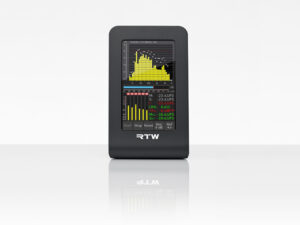
RTW debuted the new MM3 MusicMeter for loudness metering in editorial suites, with a vectorscope, PPM/TruePeak or VU metering and real-time analyzers, along with numerical and graphical loudness display and zoom modes. The meter supports analog, S/P DIF and USB inputs, while an S/P DIF digital output delivers a buffered stereo signal or a downmix from a 5.1 stream.
Solid State Logic introduced the upgraded Nucleus2 combined DAW controller, audio interface and studio monitoring unit, which now features a talkback input with adjustable gain for the headphone output. A large “talk” button added near the transport controls can trigger, if desired, a switchable -20 dB reduction in monitor outputs. A second set of speaker outputs and a “mini” monitor button also has been added to the center section for comparing mixes. Also to be seen: upgrades to the AWS 948 Delta, including Stereo Channel mode stem recording in a single pass and in-place/post-pan stereo stem generation in In-Line mode for users that print analog-processed content back to a DAW.
Sennheiser highlighted a 9.1 monitoring set-up, consisting of Neumann KH 310 and KH 120 nearfields as well as KH 810 subwoofers for medium-format re-recording stages, in addition to stereo configurations of the Neumann KH 120 and KH 310 monitors for editorial suites. Also to be seen: immersive audio material recorded with Sennheiser’s new Ambeo VR Mic, which is scheduled to become available in by year’s end. “Within the framework of our 3D audio program we have been active in the VR production field for quite some time, developing the optimum solution for immersive audio capture,” said Sofia Brazzola of Sennheiser Strategic Innovation.

Yamaha Professional Audio showcased a Nuage Advanced Production DAW System, with new V1.8 software, modular architecture and Audinate Dante networking capability. A VST-format Multi-Panner 3D surround plug-in for the included Nuendo 7.1 software offers Dolby Atmos assignment. It lets users work on a 9.1 channel bed mix and an object mix with up to 118 audio objects via a single display. Top and rear view displays are said to simplify visualization of audio images 3D positions within an immersive sound stage.
Finally, Waves Audio unveiled SoundGrid Connect, which allows users to connect any ASIO/Core Audio-compatible audio interface to a SoundGrid DSP server and boost the capacity of their DAW system, including the ability to simultaneously run multiple plug-ins, and record/mix from multiple PCs via a simple Ethernet connection. By off-loading plug-in processing to a server, post users can free up a PC’s CPU for other tasks; sound editors can also collaborate on projects and move between facilities with different systems.




